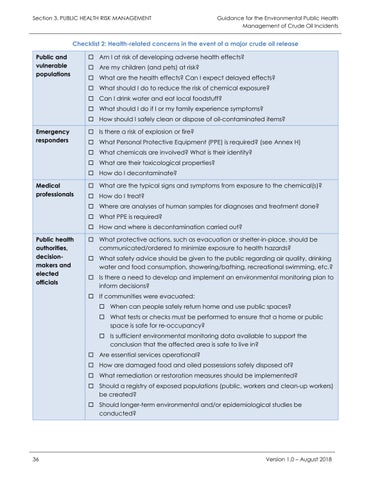Section 3. PUBLIC HEALTH RISK MANAGEMENT
Guidance for the Environmental Public Health Management of Crude Oil Incidents
Checklist 2: Health-related concerns in the event of a major crude oil release Public and vulnerable populations
Am I at risk of developing adverse health effects? Are my children (and pets) at risk? What are the health effects? Can I expect delayed effects? What should I do to reduce the risk of chemical exposure? Can I drink water and eat local foodstuff? What should I do if I or my family experience symptoms? How should I safely clean or dispose of oil-contaminated items?
Emergency responders
Is there a risk of explosion or fire? What Personal Protective Equipment (PPE) is required? (see Annex H) What chemicals are involved? What is their identity? What are their toxicological properties? How do I decontaminate?
Medical professionals
What are the typical signs and symptoms from exposure to the chemical(s)? How do I treat? Where are analyses of human samples for diagnoses and treatment done? What PPE is required? How and where is decontamination carried out?
Public health authorities, decisionmakers and elected officials
What protective actions, such as evacuation or shelter-in-place, should be communicated/ordered to minimize exposure to health hazards? What safety advice should be given to the public regarding air quality, drinking water and food consumption, showering/bathing, recreational swimming, etc.? Is there a need to develop and implement an environmental monitoring plan to inform decisions? If communities were evacuated: When can people safely return home and use public spaces? What tests or checks must be performed to ensure that a home or public space is safe for re-occupancy? Is sufficient environmental monitoring data available to support the conclusion that the affected area is safe to live in? Are essential services operational? How are damaged food and oiled possessions safely disposed of? What remediation or restoration measures should be implemented? Should a registry of exposed populations (public, workers and clean-up workers) be created? Should longer-term environmental and/or epidemiological studies be conducted?
36
Version 1.0 – August 2018







